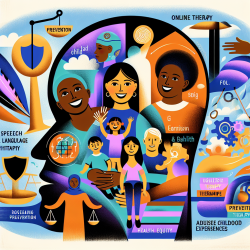Introduction
The COVID-19 pandemic has undeniably accelerated the adoption of technology across various sectors, including healthcare. This shift has been particularly significant in the realm of speech-language pathology, where virtual care has become an essential tool. The research article "Technology adoption and diffusion in healthcare at onset of COVID-19 and beyond" provides valuable insights into this transformation. This blog aims to help practitioners enhance their skills by implementing the research outcomes or encouraging further exploration.
The Rapid Adoption of Technology in Healthcare
During the pandemic, the adoption of technology in healthcare saw an unprecedented surge. According to the research, virtual care visits in Canada jumped from 4% to 60% at the onset of COVID-19. This shift was driven by the necessity to provide continuous care while minimizing the risk of virus transmission. For speech-language pathologists, this means embracing virtual platforms to deliver therapy, ensuring that children continue to receive the support they need.
Opportunities for Speech-Language Pathologists
The integration of technology in healthcare offers numerous opportunities for speech-language pathologists:
- Enhanced Access: Virtual platforms break down geographical barriers, allowing practitioners to reach children in remote areas.
- Flexibility: Online therapy provides flexibility in scheduling, accommodating the needs of both practitioners and families.
- Data-Driven Insights: Technology enables the collection of data that can be used to tailor therapy sessions and track progress more effectively.
Challenges and Considerations
While the benefits are clear, there are challenges that practitioners must navigate:
- Privacy and Security: Ensuring the confidentiality of patient data is paramount. Practitioners must use secure platforms and adhere to privacy regulations.
- Technology Accessibility: Not all families have access to the necessary technology or internet connectivity, which can limit the reach of virtual therapy.
- Adaptation and Training: Practitioners need to be trained in using new technologies effectively to deliver quality care.
Encouraging Further Research
The rapid adoption of technology presents a unique opportunity for further research. Understanding the impact of experience and voluntariness on technology adoption can lead to more effective implementation strategies. Speech-language pathologists can contribute to this body of knowledge by participating in studies and sharing their experiences.
Conclusion
The integration of technology in healthcare, accelerated by the COVID-19 pandemic, has opened new avenues for speech-language pathologists to enhance their practice. By embracing virtual care and contributing to ongoing research, practitioners can ensure that they are delivering the best possible outcomes for children. As we move forward, it is crucial to balance the benefits of technology with considerations for privacy, accessibility, and training.
To read the original research paper, please follow this link: Technology adoption and diffusion in healthcare at onset of COVID-19 and beyond.










